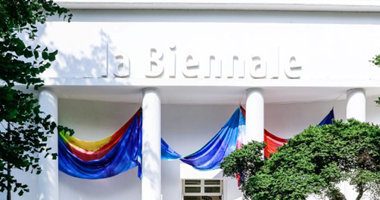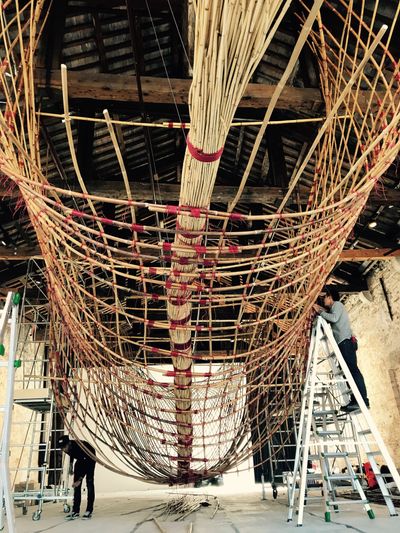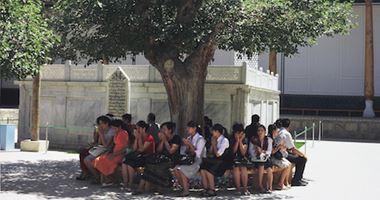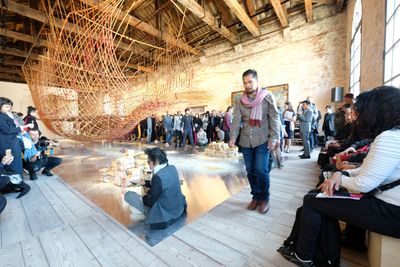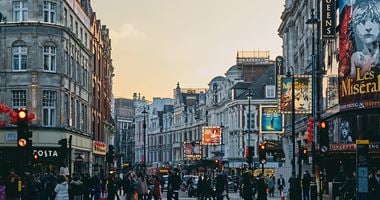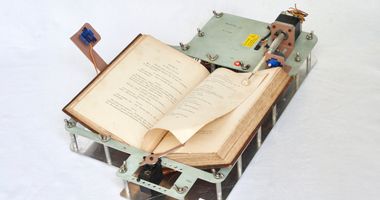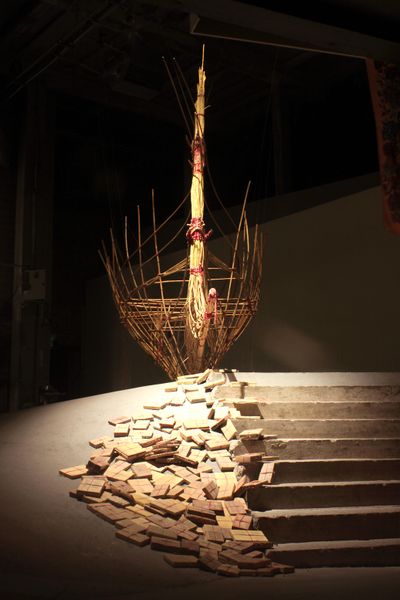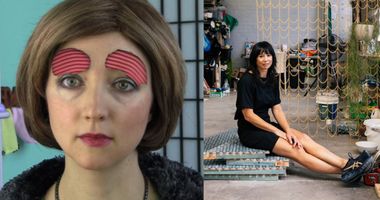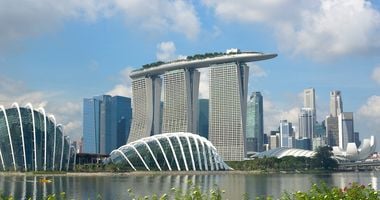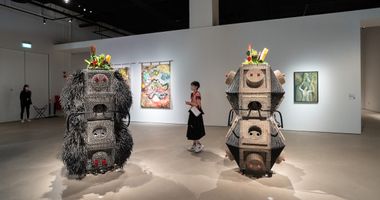Zai Kuning
Zai Kuning. Courtesy National Arts Council, Singapore.
Zai Kuning. Courtesy National Arts Council, Singapore.
A 17-metre-long boat made of rattan, beeswax and string hangs in the Singapore Pavilion in the Sale d'Armi building at the Arsenale for the 57th Venice Biennale (13 May—26 November 2017). The ship is the centrepiece of Dapunta Hyang: Transmission of Knowledge (2017), a presentation by multidisciplinary artist Zai Kuning.
It is his fifth such vessel and his most intricate work to date. The project combines Kuning's research into the 7th-century voyage of Dapunta Hyang Sri Jayanasa, the 'first Malay king', with documentation of his encounters with the orang laut, the sea people of the Riau Archipelago in Indonesia who are believed to have been the first inhabitants of what is now modern-day Singapore.
Through his research into Dapunta Hyang and the orang laut, Kuning explores what was once an influential empire which stretched across modern-day Indonesia, Singapore, Malaysia, Thailand, Vietnam and Cambodia. Dapunta Hyang has been largely forgotten in a regional memory that mostly begins with post-14th-century history.
Alongside the suspended ship in Venice hangs a series of photographs of performers of mak yong, a pre-Islamic operatic and performative tradition which few still practice. An audio recording of an old mak yong master plays on loop in the space.
Kuning worked out of a studio at Gillman Barracks in preparation for the Venice Biennale presentation. I spoke with him prior to the Biennale's opening.
EADapunta Hyang: Transmission of Knowledge_ is a culmination of over 20 years of research on Malay culture and Southeast Asian history. You've referred to Dapunta Hyang as the 'first man' in Malay history, and similar to Alexander the Great in that he desired to conquer the world. Can you tell me about this seventh century figure and your artistic fascination with him?
ZKSingaporean—and Malay especially—history has always been tied to the empire and the last king of Singapura [1344—c. 1414]. They call him Parameswara, but he had about four names which he kept changing. His final name was Iskandar, which was in fact after Alexander the Great. From the 14th century, this part of the world was a Muslim territory. But what is not known is the earlier history, from between 6th or 7th century to 14th century.
This earlier kingdom was not Muslim; the people were Hindu, Buddhist and animist. As I did more reading, I realised that it's quite a waste to not know your first king. My effort is to make it known that the history didn't start in the 14th century; it started from sixth or seventh century and with this first king.
Dapunta Hyang is believed to have had an army of 20,000 men, but it's not proven if he was a conqueror. He wanted to transmit knowledge and consciousness. Most foreigners, colonialists or outsiders would call groups of people here in the sixth or seventh century barbaric and primitive. But Dapunta Hyang made temples, and what is a temple for? It's for meditation and the sharing of knowledge about consciousness. Consciousness is also about how to be good: it teaches people to stop robbing, stop stealing, stop raping and stop killing. You can imagine that in those centuries, people's logic and ethics were, in a way, barbaric.
EAWhen did you begin to first research this?
ZKI started from scratch around 1998. But that initial search was not about this king. The search was about the original people of this island, loosely called the 'sea gypsies', or Orang Laut. For a few years, I kept looking for their territories, because they are very hidden people. Even the marine police could not find them. Bintang, Indonesia, is about two and a half hours by ferry [from Singapore]. Down there, there are hundreds of islands and the Orang Laut's territory is around there. They keep moving; that's why it's hard to follow them. They're not hiding, but you can't follow them.
EAWhy are they nomadic?
ZKThat term is problematic. They are not really gypsies, and in fact they are not nomadic. They have about fifteen islands that they visit over one year, or four seasons. They move depending on the hot seasons, cold seasons, and because in certain seasons the fish are in one place and not another. All of these places are their home. I don't consider them nomadic because they don't move aimlessly. They follow a route. They take one year to go back to the same place. The Orang Laut also don't have a written language. They don't even have passports. Their boat, their design, is their passport. The marine police ensures no one imitates their boats. They are a protected group of people.
EAYou've worked for more than two decades researching the history and culture of Southeast Asian people, making works with sculpture, installation, painting and drawing, experimental sound, music, video, film, performance art, dance and theatre. Which of these disciplines have you engaged for the project in Venice?
ZKThe entire process of making the ship is a laborious one. To prepare and tie the rattan alone required three men over a period of one month. We are working on a very tight timeline to build the ship onsite. I have two technicians from Singapore with me, and three from Venice. They work very hard and we have barely two weeks left. It is still a long way to go, but I am happy with the progress. This will be the fifth ship I've made and is a way to question techniques of ship-making. When I researched Viking ships, I learned that they used nails and metal to build them.
Some other ship-making strategies involve a lot of materials that I'm sometimes unfamiliar with. And in some cases, there were not many materials to use. You may have only had two or three materials and only two or three tools. A knife, and a big nail to knock. In a way, the use of primitive tools evolved into a technique. That challenged me because I have the luxury of materials. My paint, for example, is from London, my canvas and paper is from London, some from Paris, some from China.
How creative am I?' And how good am I at the manipulation of a material?
So I began to change the materials I use. I use natural material only found in Southeast Asia like string, wax and rattan. Rattan is famous for making many things like baskets, boats and even houses. It's free and grows in abundance. If you are architecturally well-informed and you are given only this material, you can make something. I completely departed from my past luxury of expensive paper and expensive brushes and started to use these cheap things [laughs]. I challenged myself and asked, 'How creative am I?' And how good am I at the manipulation of a material?' This is what you cannot learn in art school. The challenge is internal and mental. We always want a shortcut. I am simply trying to improve my way to deal with the material to make a big vessel.
The design and structure has taken me a few years to develop. For the Venice Biennale, the difficulty lies in narrating a story based on two different things. It isn't just about the ship and its history and the Orang Laut, it's also about the performers of mak yong, an ancient operatic tradition. How is one to put them together?
Contemporary audiences are no longer interested in this type of music. The singers use the language, intonations and mannerisms of the ancient Malay. In Singapore, the Malay don't speak like that anymore; their spelling and pronunciation has evolved many times. For example, in the past, my name was pronounced 'Zai-ah'. Then it changed to 'Zai-yeuh'. The opera singers will say 'ow', which means yes. The Malay here don't say 'ow' anymore. They say 'ya'.
From the 14th century, language was refined to unite the people. The whole of Southeast Asia is a trading point where people must find a common language with which to trade and exchange. Singapore is special because we are so multicultural: there are many Chinese, Malay and Indian people. The Orang Laut speak Malay, of course, but can incorporate some Hindi, Chinese and Vietnamese.
The portraits and audio recordings of mak yong performers are new additions to the work and were made specifically for Venice.
EAYou've said that democracy is a faulty device in the experience of Southeast Asian people. Why is that?
ZKTrading is important part of Southeast Asian history because it was the beginning of exchange, and you must find a language to communicate. Farmers didn't go fishing, so they went down to the sea and said, 'We want fish'. And then the fishermen said, 'Well, we want rice! We want fruit!' This evolved as people came to use silver or metal or coins, things that they considered better than fish.
I think democracy is connected to the introduction of economy through currency, and trade is a process of developing respect in the democratic exchange of something. We are not here to rob each other. There is a lot of robbing in these states, which have been very famous for pirates here for hundreds of years. But I cannot define a clear idea of what democracy is based on European or American theories. It's quite different in certain regions in Southeast Asia, because it isn't based on Western philosophy.
There are many artists who work in a way that is mainly influenced by European contemporary art.
EAThe work in Venice will be your most complex and intricate installation to date. How have you and the team, including photographer Wichai Juntavaro, worked together on it?
ZKI have worked with Wichai for five years already. I'm very interested in him because he comes from a region in Thailand where there is one of the original dances related to the mak yong. They are also Hindu-based, not Buddhist. He has many memories about that. His mother, uncle and cousin are related to the opera I wanted to be connected with him, this person born connected to the source. For a few years since we met, I would go to Thailand. I brought him to Mantang island four years ago where we stayed for a few days to document and archive.
EAWhat does the mak yong opera singing sound like?
ZKHow can I describe it? It is not what Malay opera sounds like now. Basically, their kind of music, singing and dancing, only they do it. No one else does it. That's the reason I'm very passionate about it and have been following them for the past 14 or 15 years.
EAThe uncovering of forgotten histories is a pertinent concern in Singapore. Do you feel that contemporary art in Singapore is addressing the diversity of Singapore's ethnic history?
ZKWell, there are a lot of artists in Singapore. I think everyone chooses specific ways to work, intellectually, conceptually or even religiously. There are many artists who work in a way that is mainly influenced by European contemporary art. I think it's important we have a variety of artists, intellectually, who go deep into history. That's my personal view.
The consciousness and environment of Singapore is unique. We are multicultural, very small, and can access information very quickly. Living here is compact and someone else is always near. It's a luxury in Singapore if you walk around and don't see anyone. This is why I travel a lot. When my friends ask me where I want to go, I say, 'Where there are no human beings.'
EAThe Orang Laut must not see many people.
ZKThey're like snakes, they don't like people. I travelled for one year on a small boat and kept searching but could not find them. Many people told me I wouldn't be able to. You have to wait somewhere.
EACould their dialect of Malay be considered a preservation of the Malay that used to be spoken?
ZKThere is no preservation. The Orang laut speak basically four languages, not one. This is because they trade with people from different areas who speak differently. So when I go to Thailand with my Thai friend who brought me to see the sea gypsies there, immediately I could speak with them because they speak Malay. And they speak Thai, and they can speak Chinese because they sell their fish to Chinese people.
EASingapore remains a trading hub today, at least for the finance industry, in a similar way to Hong Kong. But in Hong Kong, the dominant language of that trade has been English. Is there an erasure of the previous language of trade?
ZKIn terms of commerce, no. Economy is the same. But Singapore is different from Hong Kong. You go to Hong Kong and you cannot hear someone speak Malay right away. Here you can hear the sound of Malay instantly. If you go into a coffee shop, they play different music. We have a lot more spice here because that's our history. It's all about spice. When the Europeans and Indians came here, it was for spice, gold, tin and silver. Maybe more than that [laughs].
EAYou said that you hope your work for the Biennale will expand the sense of time and space that Singaporeans have of their history and identity. How do you hope to do this?
ZKMy goal is to talk with audiences elsewhere about what exactly Singapore is. Let's not only talk about politics or religion. The people here are not only what many people get from the news. I'm trying to provide people with complete information or knowledge about time.
In Singapore, most people only start with the history of modern Singapore, beginning with Raffles in the 18th century. I think Singaporeans will be richer if they are more informed about their past. There's no pain in knowing your great-great grandmother. It's a challenge, but I think it is a live work.
EAIt reminds me of the humbling way one realises just how vast the universe is when studying astronomy. One begins to consider themselves as part of something much larger than they previously thought. Considering a greater breadth of history can similarly expand your sense of space and time.
ZKPeople sometimes fight about who knows the truth or not. For me, it shouldn't be so self-righteous and egotistic. That's why the work I do is all about evidence, not only my artistic imagination. This to me is a language that doesn't need much explaining. It's not what I make of it, it just is. When I give talks at universities, I always guide students to look at the evidence. Never argue only based on your own idea and imagination.—[O]



